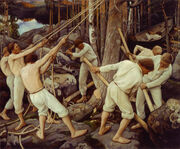| |||||
| Anthem | "Maamme / Vårt land" | ||||
| Capital (and largest city) |
Helsinki | ||||
| Other cities | Espoo, Tampere | ||||
| Language | Finnish | ||||
| Religion main |
Evangelical Lutheranism | ||||
| others | Finnish Orthodoxy, Catholicism | ||||
| Demonym | Finnish | ||||
| Government | Constitutional monarchy | ||||
| Internet TLD | .fl | ||||
| Organizations | League of Nations, European Union | ||||
Finland (Suomen kuningaskunta) is a nation in northern Europe. It borders Norway, Sweden, and Russia. It is the eighth largest nation in Europe, though it is also one of the most sparsely populated. The Greater Helsinki area produces a third of Finland's GDP.
History[]
Swedish era[]
Swedish kings established rule in the Northern Crusades from the 12th century until 1249. The area of present-day Finland became a fully consolidated part of the Swedish kingdom; Swedish-speaking peoples arrived on the Finnish coast during the Middle Ages. Swedish became the dominant language shortly after, with Finnish becoming a language chiefly used by the peasantry, clergy, and local courts. During the Protestant Reformation, the Finns gradually converted to Lutheranism. During the 1690s, Finland suffered a severe famine, killing off a third of the Finnish population. Another devastating plague followed. In the 18th century, wars between Sweden and Russia reminded the Finnish people of how dangerous their position between the two nations was. These wars led to occupation of Finland on two separate occasions by Russian forces, times known to the Finns as the Greater Wrath and Lesser Wrath.
Russian era[]

A painting of Finnish pioneers working in Karelia
After the end of the Finnish War, Finland became incorporated into Russia's autonomous Grand Duchy of Finland, which lasted until the end of 1917. During the Russian era, the Finnish language gained recognition and gained the same legal status as Swedish. From the 1860s onwards, a large Finnish nationalist movement known as the Fennoman movement was published; resulting in the Finland's national epic-Kalevala being published. However, economic and political development was rapid, with the GDP per capita being half of that of Britain's.
Independence & Modern Day Finland[]
After the February Revolution, the position of Finland as a part of Russia was questioned, mainly by Social Democrats. Since the head of state was the tsar, it was not clear who Finland's chief executive was after the revolution. New elections were held in which right wing parties won for the most part; despite social democrats having control over the Finnish government. After the October Revolution, the government declared independence in 1917. Germany seized the opportunity to take advantage of Finland's confusing political situation; putting the prince of Hesse in power in Finland, creating a regime loyal to Germany. However, Germany and ally Sweden had a minor dispute over the region; Swedish agents tried launching coups against the king on multiple different occasions in order to create a Swedish vassal. However, Finland remains independent to this day and still has great ties with Germany even a century later. Finland is a socialist constitutional monarchy just like its Nordic neighbors.
Demographics[]
Ethnic groups[]
| Number | Group |
|---|---|
| 1 | Finns |
| 2 | Swedes |
| 3 | Romani |
| 4 | Jews |
| 5 | Russians |
Religion[]
| Number | Group |
|---|---|
| 1 | Evangelical Lutheranism |
| 2 | Atheism |
| 3 | Orthodoxy |
| 4 | Catholicism |
| 5 | Islam |
| |||||||||



